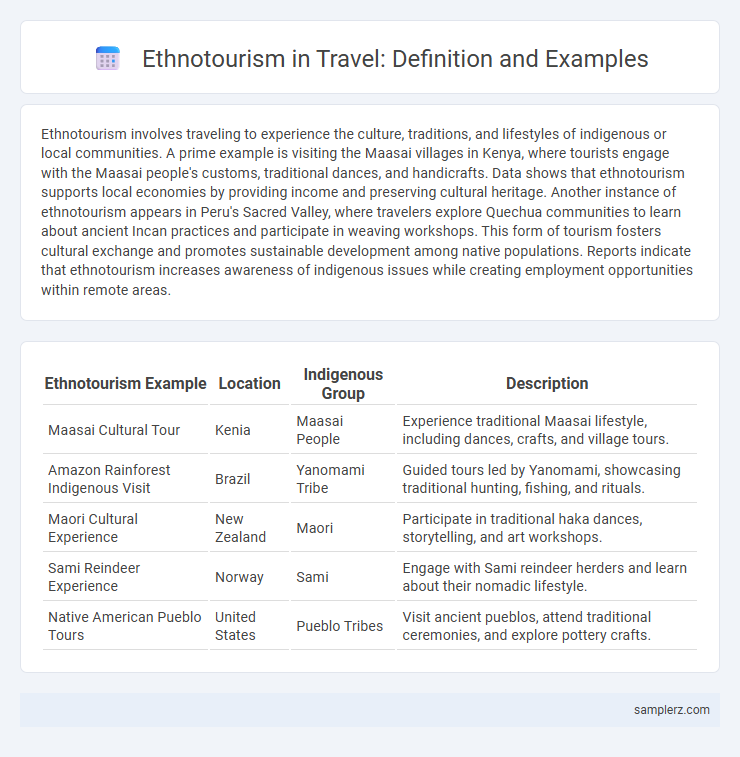Ethnotourism involves traveling to experience the culture, traditions, and lifestyles of indigenous or local communities. A prime example is visiting the Maasai villages in Kenya, where tourists engage with the Maasai people's customs, traditional dances, and handicrafts. Data shows that ethnotourism supports local economies by providing income and preserving cultural heritage. Another instance of ethnotourism appears in Peru's Sacred Valley, where travelers explore Quechua communities to learn about ancient Incan practices and participate in weaving workshops. This form of tourism fosters cultural exchange and promotes sustainable development among native populations. Reports indicate that ethnotourism increases awareness of indigenous issues while creating employment opportunities within remote areas.
Table of Comparison
| Ethnotourism Example | Location | Indigenous Group | Description |
|---|---|---|---|
| Maasai Cultural Tour | Kenia | Maasai People | Experience traditional Maasai lifestyle, including dances, crafts, and village tours. |
| Amazon Rainforest Indigenous Visit | Brazil | Yanomami Tribe | Guided tours led by Yanomami, showcasing traditional hunting, fishing, and rituals. |
| Maori Cultural Experience | New Zealand | Maori | Participate in traditional haka dances, storytelling, and art workshops. |
| Sami Reindeer Experience | Norway | Sami | Engage with Sami reindeer herders and learn about their nomadic lifestyle. |
| Native American Pueblo Tours | United States | Pueblo Tribes | Visit ancient pueblos, attend traditional ceremonies, and explore pottery crafts. |
Unique Ethnotourism Experiences Around the World
Exploring the Sami culture in northern Scandinavia offers travelers an immersive ethnotourism experience through traditional reindeer herding and vibrant joik music. Visitors to Bali engage with the island's indigenous Balinese Hindu rituals and artisanal crafts, deepening cultural appreciation. In Peru, guided tours of Quechua villages around Machu Picchu highlight ancient Andean traditions, providing a unique connection to indigenous heritage.
Top Destinations for Authentic Cultural Immersion
Top destinations for authentic cultural immersion include Oaxaca in Mexico, renowned for its vibrant indigenous Zapotec traditions and colorful festivals. In Japan, visiting Kyoto offers ethnotourism experiences through ancient tea ceremonies and traditional crafts preserved by local communities. Ghana's Ashanti Region provides travelers with deep insights into Akan culture, including royal palaces and kente weaving workshops.
Indigenous Communities Offering Ethnotourism Activities
Indigenous communities in regions like the Amazon Rainforest and the Australian Outback offer authentic ethnotourism experiences that showcase traditional customs, crafts, and rituals. Visitors engage in guided tours, participate in cultural ceremonies, and learn sustainable practices that preserve ancestral knowledge. These immersive activities promote cultural exchange while supporting the economic development of Indigenous peoples worldwide.
Responsible Ethnotourism: Case Studies and Best Practices
Responsible ethnotourism emphasizes respectful engagement with indigenous cultures, promoting sustainable practices that benefit local communities while preserving their heritage. Case studies from Costa Rica's Bribri tribe highlight collaboration between tourists and locals to support traditional crafts and ecological knowledge, ensuring both cultural integrity and environmental conservation. Best practices include transparent communication, fair compensation, and immersive experiences that foster cultural appreciation without exploitation.
Traditional Festivals Celebrated by Tourists
Traditional festivals such as the Day of the Dead in Mexico attract tourists eager to experience indigenous customs, vibrant costumes, and ancestral rituals. In Japan, the Gion Matsuri festival offers visitors an immersive view of Shinto traditions through elaborate floats and street performances. These ethnotourism events provide authentic cultural encounters that preserve heritage while fostering sustainable tourism.
Guided Ethnotourism Tours with Local Tribes
Guided ethnotourism tours with local tribes offer travelers immersive experiences that highlight indigenous customs, rituals, and traditional lifestyles. These tours provide authentic interactions with tribal communities such as the Maasai in Kenya, the Quechua in Peru, or the Hmong in Vietnam, promoting cultural preservation and economic support. Participants gain deeper understanding of ancestral knowledge and artisanal skills while contributing to sustainable tourism efforts.
Homestays and Village Life: Living Like a Local
Ethnotourism through homestays offers travelers immersive experiences in traditional village life, allowing guests to live like locals and engage directly with indigenous cultures. Staying with local families provides authentic opportunities to participate in daily routines, traditional crafts, and community festivals, enriching cultural understanding. These immersive stays support sustainable tourism by fostering cultural preservation and empowering rural communities economically.
Hands-On Workshops in Ethnic Crafts and Cuisine
Hands-on workshops in ethnic crafts and cuisine offer immersive ethnotourism experiences by allowing travelers to actively engage with local traditions and skills. These workshops often include pottery making, weaving, or cooking traditional recipes under the guidance of community artisans. Participation fosters cultural understanding, preserves heritage, and supports indigenous economies through sustainable tourism practices.
Rituals and Ceremonies: Participating Respectfully
Experiencing ethnotourism through rituals and ceremonies offers travelers authentic cultural immersion while fostering respect for local traditions. Engaging in indigenous festivals or spiritual ceremonies, such as the Balinese Nyepi Day or the Maasai Eunoto rite, requires understanding and honoring community protocols to avoid cultural appropriation. Respectful participation enhances meaningful connections and preserves the integrity of these cultural heritage events.
Protecting Heritage: Successful Ethnotourism Projects
The Maasai Mara Cultural Village in Kenya offers immersive experiences that support Maasai traditions while generating sustainable income, fostering both economic development and heritage preservation. In Guatemala, the highland town of Chichicastenango promotes K'iche' Maya culture through vibrant markets and traditional ceremonies, attracting tourists who contribute to safeguarding indigenous customs. Peru's Sacred Valley ethnotourism initiatives engage Quechua communities in cultural exchanges and handicraft sales, ensuring the transmission of ancestral knowledge and protection of archaeological sites.

example of ethnotourism in travel Infographic
 samplerz.com
samplerz.com